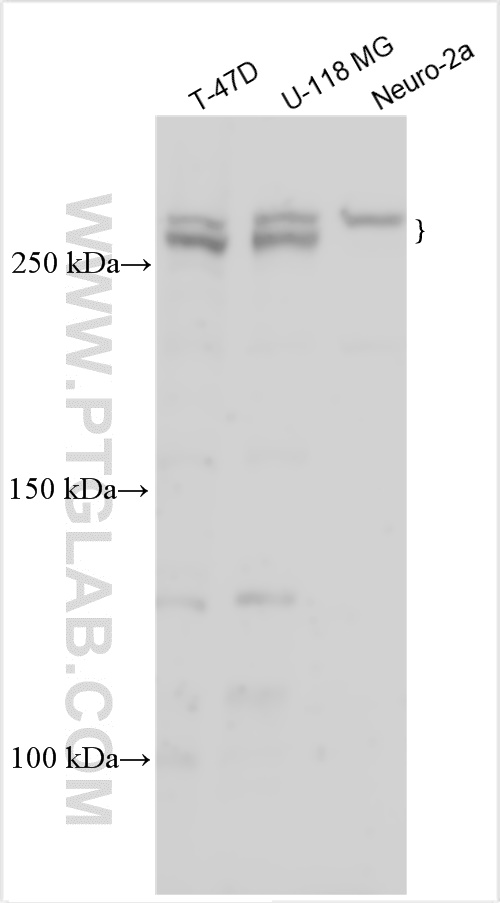验证数据展示
经过测试的应用
| Positive WB detected in | T-47D cells, U-118 MG cells, Neuro-2a cells |
推荐稀释比
| 应用 | 推荐稀释比 |
|---|---|
| Western Blot (WB) | WB : 1:500-1:3000 |
| It is recommended that this reagent should be titrated in each testing system to obtain optimal results. | |
| Sample-dependent, Check data in validation data gallery. | |
产品信息
55207-1-AP targets GOLGA4 in WB, ELISA applications and shows reactivity with human, mouse samples.
| 经测试应用 | WB, ELISA Application Description |
| 经测试反应性 | human, mouse |
| 免疫原 | Peptide 种属同源性预测 |
| 宿主/亚型 | Rabbit / IgG |
| 抗体类别 | Polyclonal |
| 产品类型 | Antibody |
| 全称 | golgi autoantigen, golgin subfamily a, 4 |
| 别名 | MU RMS 40.18, Golgin subfamily A member 4, Golgin 245, GOLG, GCP2 |
| 计算分子量 | 161 kDa |
| 观测分子量 | 260-270 kDa |
| GenBank蛋白编号 | NM_002078 |
| 基因名称 | GOLGA4 |
| Gene ID (NCBI) | 2803 |
| RRID | AB_3670242 |
| 偶联类型 | Unconjugated |
| 形式 | Liquid |
| 纯化方式 | Antigen affinity purification |
| UNIPROT ID | Q13439 |
| 储存缓冲液 | PBS with 0.02% sodium azide and 50% glycerol, pH 7.3. |
| 储存条件 | Store at -20°C. Stable for one year after shipment. Aliquoting is unnecessary for -20oC storage. |
背景介绍
GOLGA4, also known as Golgi matrix protein, is a member of the Golgin family and is mainly localized in the Golgi apparatus. It is involved in vesicle transport at the Golgi level and may play a role in the transport of GPI-anchored proteins from the Golgi network. GOLGA4 is expressed in a variety of tissues, especially in the testis, but its specific function in spermatogenesis and male fertility is not fully understood. Studies have shown that GOLGA4 knockout male mice are still fertile, and the testis and sperm morphology are normal, indicating that GOLGA4 is not essential for mouse spermatogenesis and male fertility (PMID: 32736686).
实验方案
| Product Specific Protocols | |
|---|---|
| WB protocol for GOLGA4 antibody 55207-1-AP | Download protocol |
| Standard Protocols | |
|---|---|
| Click here to view our Standard Protocols |
